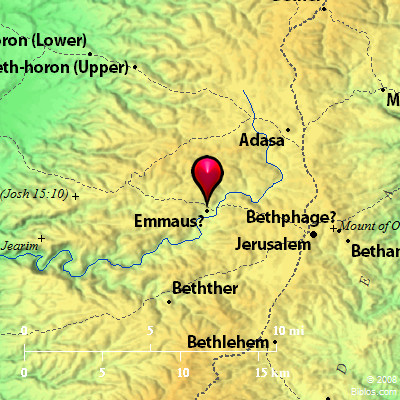Encyclopedia
EMMAUSe-ma'-us, em'-a-us (Emmaous, derivation uncertain, but probably from chammath, "a hot spring"):
Josephus (BJ, IV, i, 3) says: "Now Emmaus, if it be interpreted, may be rendered `a warm bath' for therein is a spring of warm water useful for healing." Here he is referring to the hot springs near Tiberias. Possibly the same Greek name may not always have been derived from the same Hebrew, and as Cheyne suggests (2) may have come from ha-motsah (see below).
1. Emmaus of the Apocrypha:
A place where Judas Maccabeus defeated Gorgias (APC 1Macc 4); it was "in the plain" (APC 1Macc 3:40); it was subsequently fortified by Bacchides (APC 1Macc 9:50). It is frequently mentioned by Josephus (Ant., XIV, xi, 2; BJ, I, xi, 2; II, v, 1; xx, 4; IV, viii, 1; V, i, 6), and also in the Talmud and Midrash. It is now the modern mud-village of `Amwas, 20 miles along, and a little North of, the main road from Jerusalem to Jaffa. In the 3rd century it was called Nicopolis and was an episcopal see; in early Christian times it was famous for a spring of reputed healing qualities.
2. Emmaus of Luke:
The Emmaus of Luke 24:13, a village 60 furlongs (stadia) from Jerusalem. Early Christian tradition appears to have identified it with (1) and hence, to harmonize the distance, some manuscripts have 160 furlongs. Eusebius and Jerome place this Emmaus at `Amwas; but in the first place
(1) was a city and not a village (kome), and secondly
(2) the distance, 40 miles there and back, is an almost impossible one for the narrative.
In Crusading times this difficulty appears to have been realized, and on what grounds is not known, Kubeibeh at just over 60 stadia, Northwest of Jerusalem, was selected as the site of Emmaus. There a fine church was built which has in recent years been rebuilt and today a Franciscan hospice and school, attached to the church, and a newer German Roman Catholic hospice, combine with the considerable picturesqueness of the place itself to fortify the tradition.
A much more probable site is Quloniyeh, a village about 35 stadia from Jerusalem, on the road to Jaffa. Josephus narrates (BJ, VII, vi, 6) that Vespasian "assigned a place for 800 men only whom he had dismissed from his army which he gave them for their habitation; it is called Emmaus and is distant from Jerusalem 60 furlongs." This is almost certainly the Emmaus of Luke; it is highly probable that the name quloniyeh is derived from the fact of its being this Colonia. Close to this place is a ruin known as Bet Mizza, which is probably the Mozah (ha-motsah) of Joshua 18:26 which in the Talmud (Cukk. 45) is also described as a colonia. Today it is a "colony" of Jews who have revived and always use the old name Motsah for their settlement.
Other suggestions for this Emmaus are
(a) el Khamsa, considerably over 60 stadia Southwest of Jerusalem (Conder);
(b) Koriet el `enab, some 10 stadia farther a1ong the Jerus-Jaffa road than Kuloniyeh (LB, etc.); and
(c) `Artas, S. of Bethlehem, where remains of Roman baths have been found (Mrs. Finn). In not one of the places suggested are there any hot springs.
E. W. G. Masterman
EM'MAUS, it seems probable that this village was at the place now called Amwas, 22 ms. w. of Jerusalem, since the Sinaitic manuscript reads 160 instead of 60 furlongs from Jerusalem, in Luke 24:13. This is both the proper distance and the name, if this be not accepted the place is not known.
Strong's Greek
G1695: EmmaousEmmaus, a place 60 stadia (7.5 miles) west of Jer.




